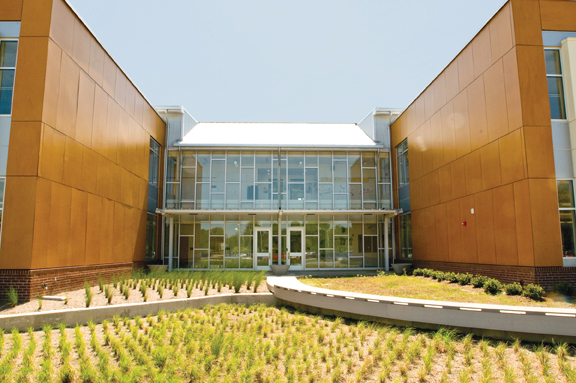From modular schools to a “test” classroom, green construction in the K-12 schools market has taken on many forms in the past decade. With school districts having to keep the needs of students in balance with limited budget flexibility, Building Teams around the country are finding ways to bring green schools into reality, whether by new construction or extensive renovation.
Chula Vista, Calif., charter school High Tech High was advised by San Diego-based general contractor BYCOR to turn to modular construction for its campus. Faced with a tight deadline and strict budget, the project also was working toward a variety of green goals, including LEED.
Modular manufacturer Williams Scotsman was brought on board to coordinate the integration of modular construction with the overall project; 59 modules totaling 32,807 sf were provided for the school, which was awarded LEED for Schools Gold certification.
In 2011 Dills Architects and McKenzie Construction completed the 94,231-sf College Park Elementary School in Virginia Beach, Va., with LEED Platinum certification in mind and net-zero stormwater management to boot. To meet the latter goal, the Building Team specified green vegetative roofing and cisterns for rainwater collection.
One Firm, multiple green certifications
Design firm SHW Group, Plano, Texas, draws from a variety of certification programs and rating systems to help build green.
The 105,000-sf Gloria Marshall Elementary School in Spring, Texas, was the first school in the Houston area to use geothermal heating and cooling. In addition to LEED Gold certification, the school received an Energy Star rating and was designed to meet Texas/CHPS (Collaborative for High Performance Schools) criteria.
The Fine Arts Facility at the 23,700-sf McCallum High School in Austin was the first educational facility in Texas to receive a five-star rating from the Austin Energy Green Building Program, the nation’s first comprehensive green building program. SHW saved the school district nearly $1 million by converting existing art rooms into science labs, building a new fine arts facility for theatre and art, and connecting the existing school with the fine arts facility.
The school also includes a “breathable” membrane that uses metal wall panels to keep moisture from getting trapped inside the wall. It is anticipated thait this will result in improved energy efficiency and indoor air quality for the school.
Green construction has also spread to the U.S. Military Academy Preparatory School at West Point, N.Y. The elite prep school moved to its new location after the former site in Fort Monmouth, N.J., was closed as part of the 2005 Base Realignment and Closure Act. The Building Team of STV (architect/engineer) and J. Kokolakis Contracting (GC) earned LEED Gold for the new facility. Environmentally conscious building practices included the procurement of materials with high recycled content, selling unused building materials to nearby manufacturers, and diverting 98.5% of C&D waste from landfill.
Many school districts, notably in California, are simultaneously implementing green building practices while using the buildings themselves to teach environmental principles to students. One such classroom, at the Davis Magnet School in Costa Mesa, was retrofitted with environmentally friendly flooring, furnishes, and paints, as well as high-performance lighting and a new ventilation system. A neighboring classroom was left unimproved.
The resulting experiment has students comparing the two classrooms to learn firsthand the benefits of sustainable educational environments. What’s more, the “greenovation,” according to Irvine-based architecture firm LPA Inc. and the Orange County chapter of the U.S. Green Building Council, came at zero cost to the school, having been funded through private donations. +
Related Stories
| Nov 18, 2014
5 big trends changing the world of academic medicine
Things are changing in healthcare. Within academic medicine alone, there is a global shortage of healthcare professionals, a changing policy landscape within the U..S., and new view and techniques in both pedagogy and practice, writes Perkins+Will’s Pat Bosch.
| Nov 18, 2014
Grimshaw releases newest designs for world’s largest airport
The airport is expected to serve 90 million passengers a year on the opening of the first phase, and more than 150 million annually after project completion in 2018.
| Nov 17, 2014
Nearly two years after Sandy Hook, the bloodshed continues
It’s been almost two years since 20 first-graders were shot and killed at Sandy Hook Elementary School in Newtown, Conn., but these incidents, both planned and random, keep occurring, writes BD+C's Robert Cassidy.
| Nov 17, 2014
Hospitality at the workplace: 5 ways hotels are transforming the office
During the past five years, the worlds of hospitality and corporate real estate have undergone an incredible transformation. The traditional approach toward real estate asset management has shifted to a focus on offerings that accommodate mobility, changing demographics, and technology, writes HOK's Eva Garza.
| Nov 17, 2014
Developments in 3D printing can assist architecture in the smallest details
Researchers at the Department of Energy’s Oak Ridge National Laboratory (ORNL) have developed a way for 3D printed metals to be produced with an unprecedented degree of precision.
| Nov 17, 2014
A new BSL-3 public-safety lab debuts in Vermont
The laboratory will be used to perform a wide range of analyses to detect biological, toxicological, chemical, and radiological threats to the health of the population, from testing for rabies, West Nile, pertussis and salmonella to water and food contaminants.
| Nov 17, 2014
'Folded facade' proposal wins cultural arts center competition in South Korea
The winning scheme by Seoul-based Designcamp Moonpark features a dramatic folded facade that takes visual cues from the landscape.
| Nov 17, 2014
Workplace pilot programs: A new tool for creating workspaces employees love
In a recent article for Fast Company, CannonDesign's Meg Osman details how insurance giant Zurich used a workplace pilot program to empower its employees in the creation of its new North American headquarters.
| Nov 17, 2014
Mastering natural ventilation: 5 crucial lessons from design experts
By harnessing natural ventilation, Building Teams can achieve a tremendous reduction in energy use and increase in occupant comfort. Engineers from SOM offer lessons from the firm’s recent work.















